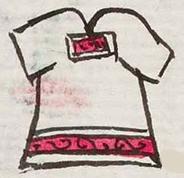huipilli (Mdz13v)
This simplex glyph of a huipilli (blouse) doubles as the glyph for the place name Huipillan. This blouse is primarily white with red and black accents. At the base of the v-neck, over the chest, is a rectangle with a white frame and a slightly smaller red rectangle inside. This red triangle has some black designs that are difficult to make out. This rectangle has been explored in the online forum, Mexicolore. But there may be more to it. The location is more or less over the heart. In the Chinantec language of Oaxaca, it has the name ki tsa kon win, rectangle of the people with a common origin. [Source: Alejandro de Avila B., "Oaxaca: Weavings that Protect the Soul," in Margarita de Orellana, Alberto Ruy-Sánchez, and Eliot Weinberger, eds., The Crafts of Mexico (Washington, D.C.: Smithsonian Books, 2004), 244.] Some of the symbols that appear in this location are also a quincunx shape (as in the Florentine Codex Book 10), associating women with the center of the universe.
At the bottom of the blouse, which is tunic-length, there is a narrow, horizontal black stripe, and below that a wider red stripe with curling black designs across it. The locative suffix (-tlan, which goes to -lan before the stem ending in the letter l, -huipil).
Stephanie Wood
The double l in Spanish had a different sound from the single l, many double ll's went to a single l in Nahuatl. But in Nahuatl, as a rule, the double l was pronounced the same as a single l.
Tunics (called huipiles in Spanish) could be made for men or women. They were woven on backstrap looms. One of the garments called a huipilli, below right, is covered with yellow feathers, and was probably a male warrior's tunic. Women's tunics very typically had the reinforcing triangle at the bottom of the v-neck. The designs of women's tunics could also very considerably, as other iconographic examples in this collection will show.
Stephanie Wood
c. 1541, but by 1553 at the latest
Stephanie Wood
blouses, clothing, textiles, blusas, ropa, huipiles

blouse, shift
Stephanie Wood
Codex Mendoza, folio 13 verso, https://digital.bodleian.ox.ac.uk/objects/2fea788e-2aa2-4f08-b6d9-648c00..., image 37 of 188.
The Bodleian Libraries, University of Oxford, hold the original manuscript, the MS. Arch. Selden. A. 1. This image is published here under the UK Creative Commons, “Attribution-NonCommercial-ShareAlike 3.0 License” (CC-BY-NC-SA 3.0).

